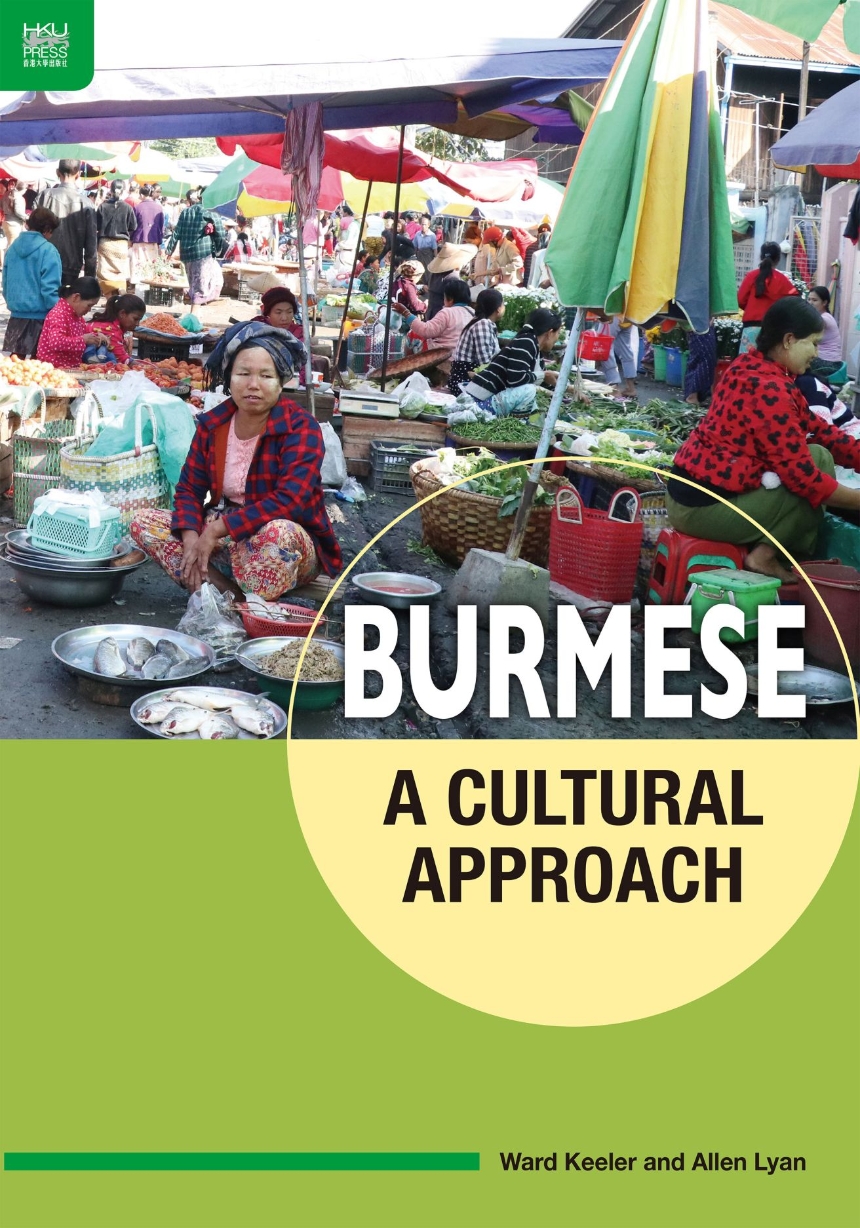A thorough and systematic introduction to the Burmese writing system.
Appropriate for use by students at varying levels of competence, Burmese: A Cultural Approach provides a thorough and systematic introduction to the Burmese writing system, along with a series of true-to-life conversations. The first part of the book offers an introduction to the Burmese sound system, while the second section focuses on conversation, including extensive annotations that illustrate grammatical patterns, characteristic turns of phrase, and typical habits of social interaction. Employing an anthropological approach to language learning, the book is intended to provide students with useful insights into how cultural understandings, not just grammar, shape what gets said in Burmese. The book is enhanced by audio files that can be accessed on a companion website that were recorded by native speakers for all the written symbols, dialogues, and exercises in the book.
Appropriate for use by students at varying levels of competence, Burmese: A Cultural Approach provides a thorough and systematic introduction to the Burmese writing system, along with a series of true-to-life conversations. The first part of the book offers an introduction to the Burmese sound system, while the second section focuses on conversation, including extensive annotations that illustrate grammatical patterns, characteristic turns of phrase, and typical habits of social interaction. Employing an anthropological approach to language learning, the book is intended to provide students with useful insights into how cultural understandings, not just grammar, shape what gets said in Burmese. The book is enhanced by audio files that can be accessed on a companion website that were recorded by native speakers for all the written symbols, dialogues, and exercises in the book.
276 pages | 7 x 10 | © 2021
Asian Studies: Southeast Asia and Australia
Language and Linguistics: Language Studies
Table of Contents
Acknowledgments
A Note on the Authors
Introduction 1
Part One: Learning to Read and Write
Lesson 1: The Syllabary 7
A. The first two lines 8
B. The fourth and fifth lines 10
C. The sixth and seventh lines 10
D. Numbers 1 to 10 11
Lesson 1: Review 12
Lesson 2: Open Vowels 13
A. – ? – ? 13
B. – ?? – ?? 15
C. ? ? ?? 17
D. ? ? ?? 18
E. ? –?? ? – ? – ? 20
F. ?? – ?? ? 22
G. ? – ?? ? – ?? ? – ? 23
H. ?? ? 24
I. ??? ?? ??? 26
Lesson 2: Review 28
Lesson 3: Glottal Stops and Nasals 29
A. –?? 29
B. –? ? 31
C. ? – ??? 32
D. ???? 34
E. –? ? 35
F. –?? 36
G. –?? 37
H. –? ? 39
I. ??? 40
J. ??? 41
K. –? ? 42
L. –? ? 44
M. ???, ???, ???, and ??? 45
N. ?? 46
Lesson 3: Review 48
Lesson 4: Consonant Clusters 49
A. ? and ? 49
B. ? 51
C. ? 52
Lesson 4: Review 55
Lesson 5: Miscellaneous Writing Matters 56
A. ? 56
B. Pali syllables 57
C. Stacked syllables ????????? 58
D. ? 60
E. Names of the syllables ????? 61
F. Names of the diacritics ????? 62
G. Special syllables ????? 62
Lesson 5: Review 65
Appendix I: On Using the Dictionary 66
Part Two: Dialogues
Lesson 6: Breakfast 71
Lesson 7: Greetings! 76
Lesson 8: It’s Really Hot 80
Lesson 9: I Don’t Go Out Much 83
Lesson 10: Going on a Trip 86
Review Lesson 1 89
Lesson 11: In the Palace Compound 91
Lesson 12: I’ve Come to Order Water 95
Lesson 13: Blood (Part 1) 99
Lesson 14: Blood (Part 2) 103
Lesson 15: A Visit to the Doctor 107
Review Lesson 2 112
Lesson 16: Kinship Connections 114
Lesson 17: Workers Wanted 119
Lesson 18: House for Rent 125
Lesson 19: A Wedding Invitation 130
Lesson 20: Roadside Phone 134
Review Lesson 3 138
Lesson 21: Let’s Go Eat 140
Lesson 22: First Year at the University 146
Lesson 23: Lunch Break 152
Lesson 24: A Dinner Invitation 157
Lesson 25: Sold Out 161
Review Lesson 4 167
Lesson 26: Sayings at the Dinner Table 169
Lesson 27: No Longyi, No Entry 174
Lesson 28: Mimi, an Intemperate Sleeper 180
Lesson 29: Damn! Motorcycle Trouble 184
Lesson 30: Who Is an Educated Person? 189
Review Lesson 5 194
Lesson 31: Soccer Fans 196
Lesson 32: Traffic Police 201
Lesson 33: Hotel Reception 207
Lesson 34: Father and Son 211
Lesson 35: An Act of Compassion 215
Review Lesson 6 219
Lesson 36: Thadingyut Festival 221
Lesson 37: The Drunkard 223
Lesson 38: Women’s Wiles 225
Lesson 39: Gambling 227
Lesson 40: Husband and Wife 229
Appendix II: On Numbers 232
Appendix III: Months of the Year 235
Comprehensive Vocabulary List
A Note on the Authors
Introduction 1
Part One: Learning to Read and Write
Lesson 1: The Syllabary 7
A. The first two lines 8
B. The fourth and fifth lines 10
C. The sixth and seventh lines 10
D. Numbers 1 to 10 11
Lesson 1: Review 12
Lesson 2: Open Vowels 13
A. – ? – ? 13
B. – ?? – ?? 15
C. ? ? ?? 17
D. ? ? ?? 18
E. ? –?? ? – ? – ? 20
F. ?? – ?? ? 22
G. ? – ?? ? – ?? ? – ? 23
H. ?? ? 24
I. ??? ?? ??? 26
Lesson 2: Review 28
Lesson 3: Glottal Stops and Nasals 29
A. –?? 29
B. –? ? 31
C. ? – ??? 32
D. ???? 34
E. –? ? 35
F. –?? 36
G. –?? 37
H. –? ? 39
I. ??? 40
J. ??? 41
K. –? ? 42
L. –? ? 44
M. ???, ???, ???, and ??? 45
N. ?? 46
Lesson 3: Review 48
Lesson 4: Consonant Clusters 49
A. ? and ? 49
B. ? 51
C. ? 52
Lesson 4: Review 55
Lesson 5: Miscellaneous Writing Matters 56
A. ? 56
B. Pali syllables 57
C. Stacked syllables ????????? 58
D. ? 60
E. Names of the syllables ????? 61
F. Names of the diacritics ????? 62
G. Special syllables ????? 62
Lesson 5: Review 65
Appendix I: On Using the Dictionary 66
Part Two: Dialogues
Lesson 6: Breakfast 71
Lesson 7: Greetings! 76
Lesson 8: It’s Really Hot 80
Lesson 9: I Don’t Go Out Much 83
Lesson 10: Going on a Trip 86
Review Lesson 1 89
Lesson 11: In the Palace Compound 91
Lesson 12: I’ve Come to Order Water 95
Lesson 13: Blood (Part 1) 99
Lesson 14: Blood (Part 2) 103
Lesson 15: A Visit to the Doctor 107
Review Lesson 2 112
Lesson 16: Kinship Connections 114
Lesson 17: Workers Wanted 119
Lesson 18: House for Rent 125
Lesson 19: A Wedding Invitation 130
Lesson 20: Roadside Phone 134
Review Lesson 3 138
Lesson 21: Let’s Go Eat 140
Lesson 22: First Year at the University 146
Lesson 23: Lunch Break 152
Lesson 24: A Dinner Invitation 157
Lesson 25: Sold Out 161
Review Lesson 4 167
Lesson 26: Sayings at the Dinner Table 169
Lesson 27: No Longyi, No Entry 174
Lesson 28: Mimi, an Intemperate Sleeper 180
Lesson 29: Damn! Motorcycle Trouble 184
Lesson 30: Who Is an Educated Person? 189
Review Lesson 5 194
Lesson 31: Soccer Fans 196
Lesson 32: Traffic Police 201
Lesson 33: Hotel Reception 207
Lesson 34: Father and Son 211
Lesson 35: An Act of Compassion 215
Review Lesson 6 219
Lesson 36: Thadingyut Festival 221
Lesson 37: The Drunkard 223
Lesson 38: Women’s Wiles 225
Lesson 39: Gambling 227
Lesson 40: Husband and Wife 229
Appendix II: On Numbers 232
Appendix III: Months of the Year 235
Comprehensive Vocabulary List

